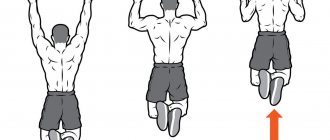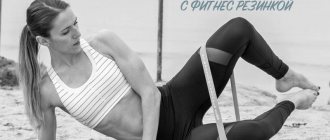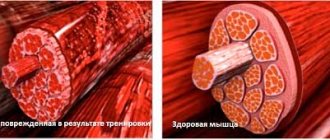The FST-7 training program does not list specific exercises that you should perform, and does not indicate exactly how you should divide your body (for example, upper and lower, chest and back, legs and shoulders, etc.) . Rather, it gives you recommendations on what to do in the last exercise for each body part worked.
The name FST-7 stands for Fascial Stretch Training , which translated means “fascial stretching training.” This indicates that one of the main goals of the program is to stretch the fascia, which is the connective membrane that covers the muscles and other organs.
Fascia is primarily responsible for helping to maintain the structural integrity of the body, providing support and protection, and also acting as a shock absorber during vigorous activity both in and outside the gym.
When the fascia stretches, muscle growth increases, and the flow of minerals, amino acids and oxygen increases.
This program involves performing 7 sets of 15 repetitions on the last exercise for each muscle group. You should rest for about 30 seconds between sets.
Note: Since you will be performing a large number of sets and repetitions, it is natural to reduce the amount of weight previously used for a particular exercise.
PROS
In addition to improving fascial health, the program helps increase overall structural flexibility of the body.
If you want to work on one specific part of the body, then the program also allows you to do this. In addition, you may reduce the overall volume of the remainder of the program due to not having time to properly rest.
Another benefit of this approach is that the high range of sets and reps will significantly stimulate your metabolism. So if your goal is to gain muscle mass or lose fat, then the results of such a workout will please you, provided that you are on the appropriate diet.
MINUSES
A potential downside that you may encounter with the program is that due to the high workload, you may not be able to train as often as you previously did. After some time, the body will likely adapt, so try not to give up on the program too quickly if it suits your goals.
If you eat properly, stretch between sessions, and don't do too much cardio, you'll likely see positive results and notice a decrease in fatigue levels.
Example training
This is another intense program, so you should always ensure your body is recovering between workouts.
Some people prefer to use the principles of the FST-7 program on a particularly weak muscle group in one workout. Others use the entire program within a week.
Expect more pain from this program than you have previously experienced, and be prepared to adjust your personal schedule accordingly. Here is an example of the FST-7 program, which applies to all muscle groups.
Note that the isolation exercise is best done with 7 reps per set.
Rest for 1-2 minutes between sets, except for exercises where you must do 7 sets. You should rest in them for about 30 seconds to ensure maximum pump.
Principles of FTS 7
Lack of acidification: the main principle that, by and large, determines everything else, since muscle “acidification” occurs through the accumulation of lactate and excessive accumulation of hydrogen ions, which leads to the destruction of mRNA, that is, muscle “acidification” is a sure sign that the training was in vain. Why? Because this is evidence that all growth factors have been destroyed . And this is the main reason why FST 7 is recommended for use by “chemists” and not “naturals”. Steroids increase not only the recovery capabilities of muscles, but also their performance due to more efficient resynthesis of ATP, so lactic acid is not scary for “chemists”, but for “naturals” it is “death”.
Exercises: Many people prefer or believe that it is better to use “shaping” exercises for “pumping”, and, in general, they are right. It cannot be said that FST 7, in principle, does not involve the use of basic exercises, but in practice this is still the case. Performing a normal 7 sets of squats or deadlifts for 8-12 reps with 30 seconds rest between sets is an impossible task. It is possible, of course, but with insignificant weights, which negates the whole point of using these exercises. On the other hand, for example, the dumbbell bench press can be used, that is, the athlete must proceed from the principle of total load when choosing an exercise. If the total load relative to the load on the target muscle group is not large, then the exercise can be used!
Target muscles: you can train any muscle group in this way, be it legs or arms, but it is important to understand that “lagging muscle groups” can only be trained in this way by “chemists”. The bottom line is that if a muscle lags behind other muscle groups in development, it means that it is genetically set worse; accordingly, the total training volume that falls on it, relative to its size, is already greater than for other muscles, so the “lagging” muscle during developmental training, you should load less, not more. “Lagging” muscles should be trained more intensively during the recovery period, but this topic deserves a separate article, as we have already written about here .
Preparation: plenty of water, pharmacology and sports nutrition are the main ways to prepare for FST 7. Before and during training, you need to drink a lot of water so that the blood does not thicken in any way. Pharmacology, in addition to steroids, involves the use of ultra-short insulin , which must be done under the supervision of a trainer and doctor, so this is also another reason to claim that this regimen is intended for professionals. For sports nutrition, it is recommended to drink liquid BCAA with water, as well as glutamine, arginine and carnitine. It goes without saying that when using pharmacology, sports nutrition does not play such a significant role, but “naturals” should “recharge to the fullest.”
Day 1: biceps, triceps and calves
- Barbell Curls: 3-4 sets of 8-12 reps
- Hammer grip dumbbell curls: 3-4 sets of 8-12 reps
- Crossover bicep curls: 7 sets of 8-12 reps
- Close grip bench press: 3-4 sets of 8-12 reps
- Seated dumbbell rows: 3-4 sets of 8-12 reps
- Crossover overhead extension: 7 sets of 8-12 reps
- Seated calf raises: 3-4 sets of 8-12 reps
- Standing calf raises: 7 sets of 8-12 reps
Basic Rules
FST-7 training aims to stretch the muscle fascia, which can interfere with muscle hypertrophy. From the name of the system you can understand what goals it pursues; you just need to decipher the abbreviation. F – fascia, S – stretching, T – training, and the number 7 indicates the number of final sets.
A little anatomy: fascia is a kind of case in which the muscle and its bundles are packed. Fascia is made up of connective tissue and is tough. Thanks to fascia, muscles have shapes that we can see in humans.
The FST-7 theory states that tight fascia acts as a limiter and prevents muscle hypertrophy, so it needs to be stretched. The more the fascia is stretched, the more muscle it can accommodate. In individuals genetically gifted for bodybuilding, the thickness of the fascia is noticeably thinner than in a less gifted person. The main tool that promotes stretching of fascia is pumping - a powerful blood supply that literally tears the muscles from the inside.
To achieve powerful pumping, FST-7 provides special approaches. The number in the title tells us about seven sets in the last exercise for the muscle group, which will allow us to fill the muscle with blood, which will ultimately lead to stretching of the fascia. But first things first.
You should not assume that the FST-7 training program is based only on pumping approaches, this is far from the case. This system includes working with heavy weights to the fullest. Therefore, working out a muscle group consists of two parts.
In the first part of the muscle group training, 2-3 basic exercises are used in 3-4 approaches. The larger the muscle group, the more exercises you can use. Weights are selected in such a way that you can perform 8-10 heavy repetitions. Before each exercise, perform 1-2 warm-up sets. The pace of performing such repetitions is standard - a slow negative phase and an explosive positive one.
After performing heavy sets, it’s time for an isolation exercise, in which you need to perform 7 sets with a rest of up to 45 seconds between sets. As a rule, the final pumping exercise uses moderate weight for 12-15 repetitions. The pace of execution is fast.
Since this is a rather traumatic training program, it is necessary to load each muscle group only once a week, not more often. Below I will give an example of one of the many FST-7 programs:
| Day 1 | Back |
| Day 2 | Deltas |
| Day 3 | Legs, abs |
| Day 4 | Chest, shin |
| Day 5 | Biceps, triceps |
| Day 6 | Rest |
| Day 7 | Rest |
STAGE T – DUMBELL PRESS ON A HORIZONTAL BENCH
Why exactly, because here each hand is responsible for itself, the weight is harder to hold in the hands, since there is no rigid support in the form of a bar, as a result, the chest will be proportionally worked out and in addition the dumbbell can be lowered lower, thereby further stretching the pectoral muscles .
1 set x 12 reps
rest – 60 seconds
2 set x 1
0 reps
rest – 60 seconds
3 sets x
8 reps
rest – 120 seconds, increasing rest slightly before the real final test.
Do you think you are already tired?! You haven't tried stage 7 yet.
What to do during training
Be sure to drink more water, which can be slightly salted.
10 minutes before training, drink 150 ml, a couple more sips between approaches. At the end of class, you can drink as much as you want. At elevated temperatures (in summer or in a stuffy room without air conditioning), you need to drink more water. You can also drink carbohydrate or thermogenic drinks, but you still need to drink water. Have you decided to drink one of these drinks during your workout? Then grab a bottle of water, drinking both liquids in turn. You will never be able to activate pumping if you don't drink water. Our body contains 70–75% water, and this level must be maintained by replenishing the fluid reserve.
Phase “7”: crossover in a cable trainer
The last exercise should be isolating. The compound exercise for the “seven” will be too difficult. Plus, the seven targets a very specific muscle, and we need to isolate it. Haney recommends using machines because you have to stay on a fixed path.
We set up the cable trainer, settled on 55 pounds (≈25 kg) and decided we would make adjustments if necessary. But we didn’t have to increase the working weight, it was already real madness. Rest between sets should not exceed 30-45 seconds. Just in case, Chris started immediately after completing my set, and I started immediately after him. As a result, each of us managed to rest for about 30 seconds.
- First set: 55 lbs (≈25 kg) – Roger 12 reps, Chris 12.
- 30 seconds rest
- Second set: 55 lbs (≈25 kg) – Roger 12 reps, Chris 12.
- 30 seconds rest
- Third set: 55 lbs (≈25 kg) – Roger 12 reps, Chris 12.
- 30 seconds rest
At this point I think I can complete all seven sets of 12 reps. I continue in the same spirit.
- Fourth set: 55 lbs (≈25 kg) – Roger 12 reps, Chris 12.
- 30 seconds rest
- Fifth set: 55 lbs (≈25 kg) – Roger 10 reps, Chris 9.
- 30 seconds rest
At this point I already understand that seven sets of 12 repetitions will not happen.
- Sixth set: 55 lbs (≈25 kg) – Roger 10 reps, Chris 10.
- 30 seconds rest
- Seventh set: 55 lbs (≈25 kg) – Roger 8 reps, Chris 8.
- 30 seconds rest
We're done. Just finished. Chris and I are going our separate ways.
Chest training program FST-7
Bench press with a positive incline 4
set of
10
reps
Dumbbell curls on a bench with a positive incline 4
set of
12
reps
Dumbbell Bench Press 4
set of
12
reps
Bringing hands together in crossover 7
sets of
12
reps
Complete Guide to FST-7
FST-7 is one of the most popular methods of high-intensity and productive training, created by Hany Rambod and used by professionals around the world.
This is the second training session of the weekly cycle using the FST-7 method and today we will train the back. Haney explained the abbreviation FTS-7:
- Fascia (Fascia): A connective tissue membrane covering organs, blood vessels, nerves and forming cases for muscles in vertebrates and humans; performs supporting and trophic functions.
- Stretch: Stretching muscles and connective tissues to become wider and larger.
- Training: The process of a person achieving a specified standard of proficiency through practice and training using advice and instruction.
- Seven: Seven approaches or sets.
https://www.youtube.com/watch?v=EC7kWsYxHvE
In the first training session, it was detailed how to train the chest using the FST-7 method. Many advanced athletes who start training on the Ramboda program fall in love with it, and after the first day of this program you will want to continue. Therefore, below is a program for training the back using the FTS-7 method.










